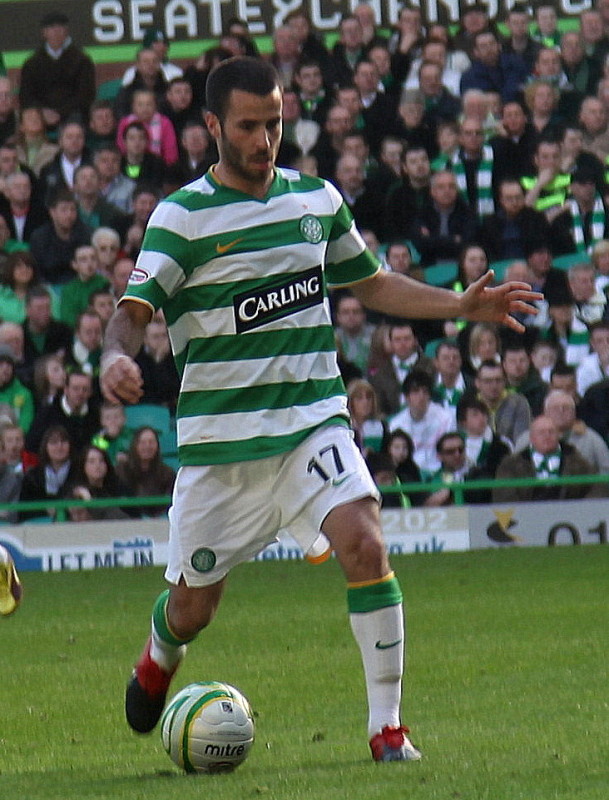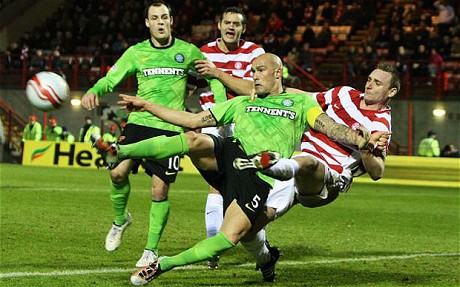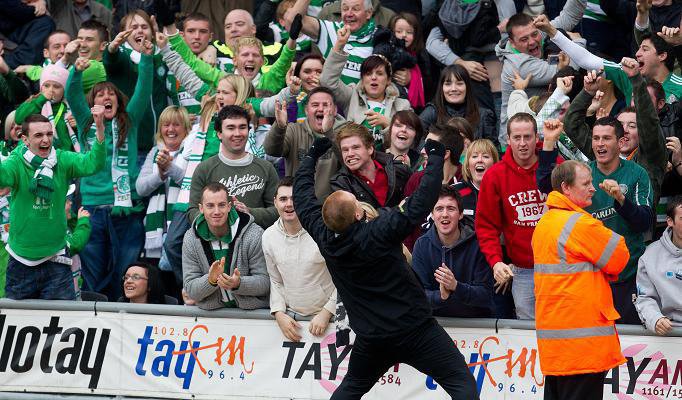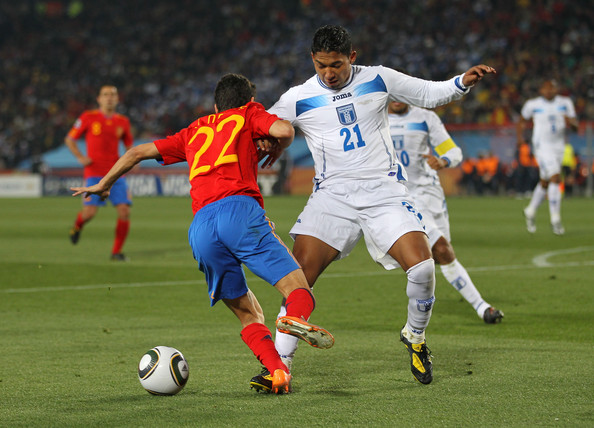As competition increases between the various European clubs scouring South America for its most talented boys, inevitably the players themselves are leaving South America increasingly early in their careers. For example, Liverpool bought young Emiliano Insua before he had even played a game for the Boca Juniors first team. Likewise Manchester United picked up the da Silva twins (Rafael and Fabio) prior to them making an appearance for Fluminense. These purchases have demonstrated how lax the Home Office has become in allowing non-EU footballers to attain work permits, something that Celtic will be able to exploit.
Last week the BBC reported that Argentina is now the world’s largest exporter of footballers. Incredibly 1716 Argentinian footballers moved abroad last year. Brazil, in second place, exported 1443 players. When Inter Milan became European Champions in May of this year it was inevitably (and only half-jokingly) referred to here in Argentina as the first South American team to win the Champions League. The claim had some substance as their starting eleven for the final contained 7 South Americans; Julio Cesar, Maicon, Samuel, Lucio, Zanetti, Cambiasso and Milito. Of course, it is not only at the highest level that South Americans are a ubiquitous presence. Serie A also-rans Catania are achieving the best ever period in their history by using their comparatively small budget wisely. They have made it a policy of scouting Argentine football extensively, to the extent that fourteen of their squad are Argentinian. Likewise, the Braga squad that knocked us out contained twenty South Americans, most of which emanate from Brazil. They may have a fraction of our budget, but then again the people in charge seem to be far more intelligent when spending their fans money. Surely it is logical that any business (including football clubs) should want to buy the best product (footballer) when its price is considerably lower than the local product. To not attempt to buy the better product (footballer) when it is cheaper, would surely indicate ignorance, negligence and incompetence on the part of the business (football club).
As I have stated in previous articles, I am of the opinion that recent Celtic managers have been narrow-minded and negligent in not looking to South America and have been illogically spending the majority of their limited budget in England; the most expensive transfer market in the world. So, with Efrain Juarez and Emilio Izaguirre arriving, is this changing? Yes and no; Neil Lennon deserves credit for having the foresight and awareness to buy players from Latin America. However, it would be overstating it to claim that this is a success of Celtic’s scouting as Juarez was first noticed at a pre-World Cup friendly against England at Wembley, Emilio Izaguirre featured prominently in the World Cup and was subsequently touted to various clubs in Europe and North America (including Rangers) and even the young boy Ruelas of Santos Laguna, that we are apparently looking at, was spotted the other week at the Milk Cup in the North of Ireland. Although these purchases were not a result of a new, extensive and impressive Latin American scouting network, their respective performances will be used as a gauge whether or not Celtic should return to the continent.
been illogically spending the majority of their limited budget in England; the most expensive transfer market in the world. So, with Efrain Juarez and Emilio Izaguirre arriving, is this changing? Yes and no; Neil Lennon deserves credit for having the foresight and awareness to buy players from Latin America. However, it would be overstating it to claim that this is a success of Celtic’s scouting as Juarez was first noticed at a pre-World Cup friendly against England at Wembley, Emilio Izaguirre featured prominently in the World Cup and was subsequently touted to various clubs in Europe and North America (including Rangers) and even the young boy Ruelas of Santos Laguna, that we are apparently looking at, was spotted the other week at the Milk Cup in the North of Ireland. Although these purchases were not a result of a new, extensive and impressive Latin American scouting network, their respective performances will be used as a gauge whether or not Celtic should return to the continent.
Despite the huge numbers of players that are being exported, the most successful South American team at the World Cup was neither Argentina nor Brazil, but Uruguay. I think that anyone who is sceptical over Latin players settling in Scottish football would have a very difficult task in naming just one player from the Uruguayan squad who would not be suited to the playing in Scotland. Their play was typified by excellent, strong defending, incessantly pressing the opposition high-up the pitch, hard tackling and adhering to their coach’s tactics. Equally when in possession, they displayed composure, good passing, a lot of pace and movement. Of course,it should be added that they were fortunate to have three excellent and clinical forwards in Forlan, Suarez and Cavani, who could make the difference in tight games.
Whilst watching their impressive performances I became curious about which players could be potentially available to Celtic. Equally, for those players who were now outwith our price range, I was interested to see how much they had been previously bought for. An example of a player that is now obviously unattainable for Celtic would be Luis Suarez-23 years old, captain of Ajax, for whom he scored 49 goals last season. Out of our price range now, yet Groningen bought him for approximately £600,000 four years ago. A year later, they sold him to Ajax for ten times that figure. A couple of other examples; Diego Godin, now of Atletico Madrid, is for me currently the best centre back in the world-like Suarez, he also left Nacional of Montevideo. Villarreal bought him three years ago for approximately £650,000. Jorge Fucile of Porto played five times for Uruguay at the World Cup. He seemed equally comfortable playing as both a right and left back. I’ll admit that I’ve only seen him in these five games but he looked impressive-a very good tackler and tidy when he had the ball. He cost Porto just £300,000.
Our competitors in Europe have been getting these players at these prices. They are the markets in which they operate and the level players that they can acquire from a very modest outlay. Equally, we should be looking to South America and acquiring the best talents available to us. The aforementioned Uruguayans are now outwith our budget, so is there anyone from their squad who Celtic could potentially purchase?
Yes, Egidio Arevalo Rios, 27, is the only member of the squad to be still playing in Uruguay, for the country’s biggest club Penarol. Arevalo Rios is the first-choice centre midfielder for the World Cup semi-finalists, keeping Gargano of Napoli and Eguren of Villareal out of the team. So important was he to coach Oscar Tabarez that he played in every single minute of all of Uruguay’s World Cup games. In fact, as Uruguay played two games that went to extra time, he probably played more minutes than any player at the World Cup.
If you can’t remember him, think of a South American Gattuso…except he can actually play a bit too. The guy has great energy, ceaselessly closing down the opposition’s creative players. He is very good positionally, screening his back four and is superb at reading where a ball is going to break, being strong in a challenge and regaining the ball for his team. His excellent defensive play was one of the main reasons that Uruguay qualified from their group stage as winners and without even a single goal conceded. Something that was noticeable was how good his timing in a tackle was and also the fact that he has a good burst of pace. This acceleration was evident in the semi-final against Germany as he skilfully juggled the ball, played a one-two with the right winger before finding Forlan who scored from his cross. Generally on the ball he is very tidy, feeding the more creative midfielders in the team, though he himself can play a very good through ball.
Following the World Cup he had agreed to move to Cagliari of Serie A for £1.9m, but the move fell through as Cagliari couldn’t finance it. After Mascherano and Essien, it is difficult to think of too many better destructive defensive midfielders in world football. This player would be an absolute guaranteed success at Celtic-just watch the video and you’ll understand why.
For me, Godin and Lugano were the best centre back partnership in the World Cup. They conceded just one goal in four games, before Lugano’s injury against Ghana broke up the partnership for the remainder of the World Cup. Had that not have occurred then who knows what would have happened-personally I would have picked a fully fit Uruguay team over this year’s Dutch squad for the semi, but I’m digressing. Uruguayan football has a history of excellent defending…perhaps hard and cynical, but still excellent defending. They currently have two of the world’s best centre backs in Lugano and Godin, along with Caceres of Juventus and Fucile of Porto completing an excellent back four. And very shortly they are going to have another excellent centre back; Sebastian Coates. Like the two Diegos (Lugano and Godin), the nineteen year old Coates has emerged from the Nacional of Montevideo youth academy. As should be expected of a 6’ 4 centre back, he can dominate both his own (and the opponents penalty) box. What I like most about him is how he reads the game and his elegance on the ball. Like Rio Ferdinand when he played at West Ham, Coates often strolls out of defence with the ball initiating his team’s play with his composure on the ball and excellent passing range. I do remember in a Copa Libertadores game against Banfield of of Argentina that he was turned twice by their quick striker Fernandez, so this would be an aspect of his play that he would need to improve.
That being said, the boy is class. At 19 he has already played two full seasons in South America’s Copa Libertadores, won the Uruguayan title with Nacional and has been called up to the national team. The media here have mentioned that Ajax and River have been watching him, though in truth every club in Europe with a scout out here will know of him. I can write on and on about him, but these videos will show you how good this boy is-especially against Estudiantes in the semi-finals of the Copa Libertadores;
The previous two Uruguayans that I have highlighted (Arevalo Rios and Coates) would, in my opinion, be guaranteed successes. I believe that Celtic should buy them as soon as possible and that they would immediately be first team players who would instantly greatly improve the standard of the team. I’m not so sure about the last player in this scouting report; Sebastian Balsas.
A few years ago Balsas emigrated to Spain with his family where he was working in a company selling mattresses. Not the typical start for international star, I’ll admit. Anyway, the story goes that Sebastian went back to Montevideo for his Christmas holidays and whilst playing 5-a-sides with his pals a local scout spotted him. To be honest, it isn’t that surprising that he was spotted, as he’s pretty difficult to miss, at 6’ 6. For the next year he tries out a various clubs, playing trial matches and reserve games and as he is preparing to give up on football to return to get a job in Spain, Racing Club of Montevideo decide to give him a contract. At Racing he does pretty well, scoring 12 in 26 games in his first season. During the close season the two biggest clubs in Uruguay, Penarol and Nacional, are now interested in the kid who was recently selling mattresses. He chooses to go to the team he supports, Nacional, and a season later they accept an offer this summer of £350,000 from Argentinian club, San Lorenzo.
To be honest, it was a bit of a strange transfer. San Lorenzo reappointed Ramon Diaz as manager, which would be akin to Martin O’Neill coming back to Celtic. Now before the season even begins, Diaz calls a press conference to say that he is going to resign unless the board provide him with the player he wants. The board duly respond by saying that everything will be resolved, but consequently the Argentine media becomes interested in what player Diaz would be so insistent on signing. Speculation emerges that the player in question might be D’Allesandro. Later, Riquelme is even muted due to his contract complications at Boca. Consequently, a few days later when everything is resolved and Diaz is delighted to announce that he now has his man, the entire Argentine sports media (and the San Lorenzo support) are perplexed at the anti-climatic arrival of an unknown 6’ 6 Uruguayan kid, who had only played 46 professional games.
Little by little, stories emerged at how well Balsas was doing. His teammates were saying that he was scoring copious amounts of goals in training and inevitably curiosity grew, including my own. I went to see him play at Racing in front of 50,000 with my Dad. For 85 minutes, he was decent though nothing special-he held the ball up well and inevitably won the majority headers against his opposing defender, but he didn’t really stand out. Until, the last 5 minutes when he forced a corner due to an excellent header, then proceeded to score a gloriously arcing header from the resulting corner.
A fortnight later, Balsas completely destroyed Boca Juniors at La Bombonera in front of 60,000 people. He practically won every high ball that was played up to him, the Boca defenders didn’t have a chance against him. To be honest, with his athletic and strong 6’ 6 physique, it was akin to watching a 15 year old play against 11 year olds in a school playground. No matter what they did, it was always going to be difficult for them to stop Balsas-it actually reminded me of Adriano a few years back when he was playing so well. Against Boca, Balsas’ link-up play was really good and he had a pretty decent first touch and close control, which surprised me. As against Racing, he scored a header. Later on, with just a few minutes remaining, he sprinted downfield 50 yards and set-up one time Celtic target, Juan Menseguez to score, to effectively seal the victory. What was interesting is the Argentina and Boca full back, Clemente Rodriguez who is one of the quickest players in Argentinian football doesn’t make up any ground on him-as well as being physically huge, having a decent touch, Sebastian Balsas is also deceptively quick.
He is far from the complete article, at times he tries to do too much with the ball, when really he should delegate that aspect of the game to more technically gifted players, whilst he himself should concentrate on winning the balls played up to him, spread the ball out to the wide midfielders and get himself into the box awaiting the cross ball. It may seem fairly basic, but with this boy’s natural physique accompanied with his athleticism and excellent heading ability, he would threaten any defence in world football. Celtic should be watching him, because the rest of Europe already are.





